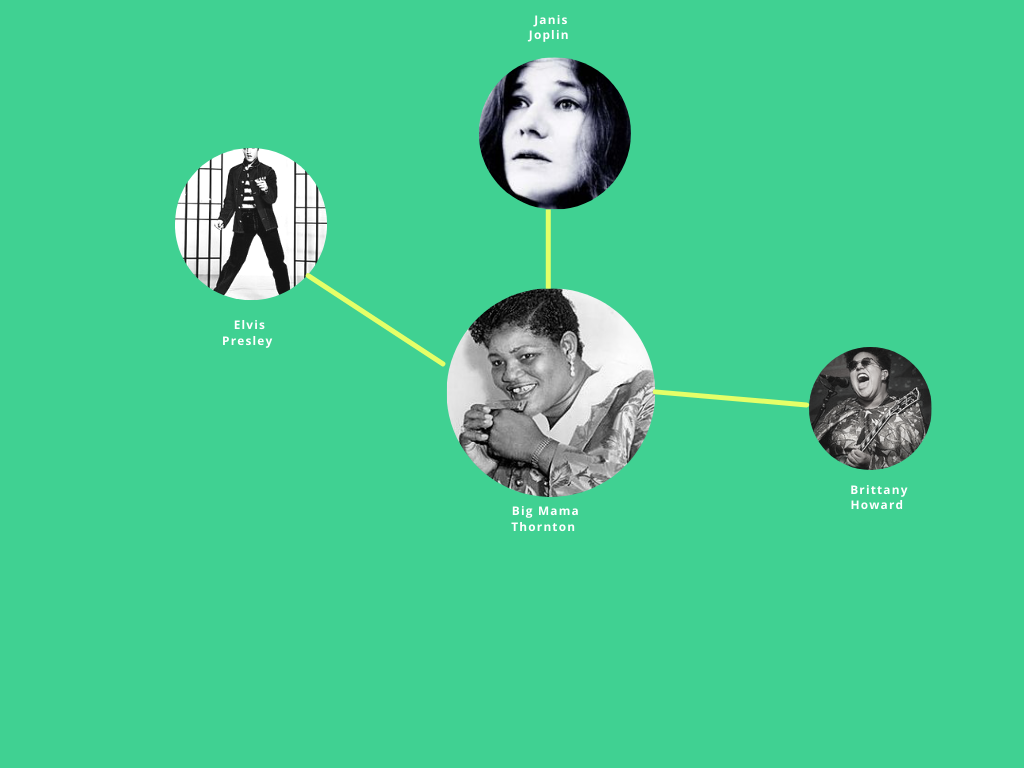
You ain’t nothing but a hound dog,
Been snooping ‘round my door
You can wag your tail,
But I ain’t gonna feed you no more
In honor of Mother’s Day, this week’s Musical Tree is going to focus on a singer who was a major influence on both blues and rock ‘n roll music. Get ready to learn about Big Mama Thornton!
Willie Mae Thornton – better known as Big Mama Thornton – was born in Alabama in 1926. Her musical education started in the church – her father was a minister and her mother sang in the church choir. Willie Mae started singing in church and also learned to play the drums and harmonica. When her mother died when she was 14 she quit school and got a job washing and cleaning spittoons in a local tavern. Sometimes she would substitute for the regular singer and, about a year later, was noticed by Sammy Green. She was hired to perform as part of his Hot Harlem Revue, where she soon was billed as the ‘New Bessie Smith’. Willie Mae performed all over the Southeast and later acknowledged the influence of artists such as Bessie Smith, Ma Rainey, and Memphis Minnie.
In 1948 Thornton left The Revue and moved to Houston, Texas where she contributed to the development of the Texas Blues style. There she ran into two individuals that would have a major impact on her career – producers Johnny Otis and Don Robey. Robey saw her perform and was so impressed with her voice that he signed her to a five-year deal with his label, Peacock Records, who had recently signed a young Little Richard. Thornton continued to perform on the southern circuit known as the ‘Chitlin’ Circuit’ – venues that were known to be safe for African American performers. In 1952 she travelled to New York City to play at the famed Apollo Theater. She started as an opening act, but was soon promoted to a headliner. It was at this time that she earned the nickname Big Mama and for the rest of her career she would be known as Big Mama Thornton. The nickname had as much to do with her size as it did with her voice – booming, yet soulful, loud and proud.

In August of 1952 she was approached by a young songwriting team who offered her a 12-bar blues vocal. The songwriters were Jerry Leiber and Mike Stoller. The name of the song was ‘Hound Dog’. Leiber and Stoller would go on to become one of the most famous rock and roll songwriting teams. I’m just scratching the surface of hits that they wrote when I mention ‘Jailhouse Rock’, ‘Young Blood’, ‘Yakety Yak’, and ‘Love Potion No. 9’. Big Mama Thornton gave them their first hit when ‘Hound Dog’ was released in 1953. ‘Hound Dog’, laden with Big Mama’s growls, barks, and sexual references, went on to sell over half a million records and went to number 1 on the Billboard R&B chart. It is often pointed to as the dawn of rock and roll. Big Mama reportedly was paid just $500.
Three years later Elvis Presley released his version of ‘Hound Dog’. The song went straight to number 1 in the U.S. and number 2 in the U.K. ‘Hound Dog’ would launch Elvis’s career and propel him to superstar status. There is no way to quantify how much money Elvis made from ‘Hound Dog’, but it’s safe to assume it was more than $500! Lieber and Stoller at first did not like Elvis’s version. Lieber wrote “I have no idea what that rabbit business is all about. The song is not about a dog, it’s about a man, a free-loading gigolo”. Elvis’s version sold more than 10 million copies, so I’m guessing Lieber and Stoller learned to like it. So many people today aren’t even aware ‘Hound Dog’ originated as an anthem of female power.
Big Mama’s career started to fade in the 1950’s. However, the blues revival that was influenced by many 1960 rock bands helped revitalize her career somewhat. By now Big Mama had relocated to the San Francisco Bay area. She recorded a couple of blues compilation albums with blues masters such as Muddy Waters and Buddy Guy. However, it was a performance in a small club in 1967 San Francisco that would have a huge impact on the second half of her career. Seated in the club that night was a huge fan of Big Mama Thornton, a blues singer who listed Big Mama as her biggest influence. That singer was Janis Joplin. Joplin and her band, Big Brother and the Holding Company, started performing Big Mama’s song ‘Ball and Chain’, including at the Monterey Pop Festival in 1967 where it received huge critical acclaim. The song would become a staple of Joplin’s sets for the rest of her brief career.
Big Mama had recorded ‘Ball and Chain’ in the early 1960’s. However, her label never released the song and retained the rights so Big Mama did not get paid for her efforts. In a 1972 interview, Big Mama acknowledged that Janis Joplin, who released the song on a couple of albums, had reached out to her and had given Big Mama a share of the royalties. Joplin even had Big Mama open for her on some of her tours, and Big Mama became a fixture at rock festivals around the Bay Area, often sharing the bill with Janis Joplin, The Grateful Dead, and Santana.
Big Mama’s popularity started to wane in the 1970’s. As the end of the decade approached years of heavy drinking began taking a toll on her health. She still continued performing however. In 1983 she survived a serious auto accident and made a triumphant return to the stage at the Newport Jazz Festival, performing on the bill with Muddy Waters, B.B. King, and Eddie “Cleanhead” Vinson. These outstanding blues performances were captured on a live recording titled ‘The Blues – A Real Summit Meeting’. Big Mama Thornton recorded one final album in 1984 titled ‘Quit Snoopin’ Round My Door’ but before the album was released she died of a heart attack in Los Angeles. Willie Mae “Big Mama” Thornton was 57 years old. The funeral was led by her old friend, now a reverend, Johnny Otis. Later that year she was inducted into the Blues Hall of Fame.
Big Mama Thornton was a huge influence on both blues and rock music, yet she never has received the recognition that she deserves. She is often overlooked when discussing early influences in popular music. The Rock and Roll Hall of Fame included her song ‘Ball and Chain’ in the list of ‘500 Songs That Shaped Rock and Roll’, yet Big Mama is not in the Rock and Roll Hall of Fame as an early influence. What is even stranger is that two of her influences, Bessie Smith and Ma Rainey, are inducted as early influences. Why is that? Perhaps the Rock and Roll Hall of Fame will correct this slight, as they did for Sister Rosetta Tharpe in 2018.
Big Mama’s influence can be felt and heard across many performers, including those performing today. Next time you are sitting by a window looking out at the rain if something comes by and grabs you, just like a ball and chain, it might just be Big Mama chasing away that hound dog and looking for a little love.
I hope you enjoyed this week’s Mother’s Day Musical Tree! Feel free to leave suggestions for future articles in the comments. Don’t forget to subscribe to be notified via email when there is a new post.
And you can now follow Tekesmusings.com on your social media of choice by clicking on the links at the bottom of the page! Until then, follow your passion, stay happy, and be thankful for whatever inspires you.


I had The Blues – A Real Summit Meeting on vinyl, used to play it all the time on my radio show in college. Awesome.